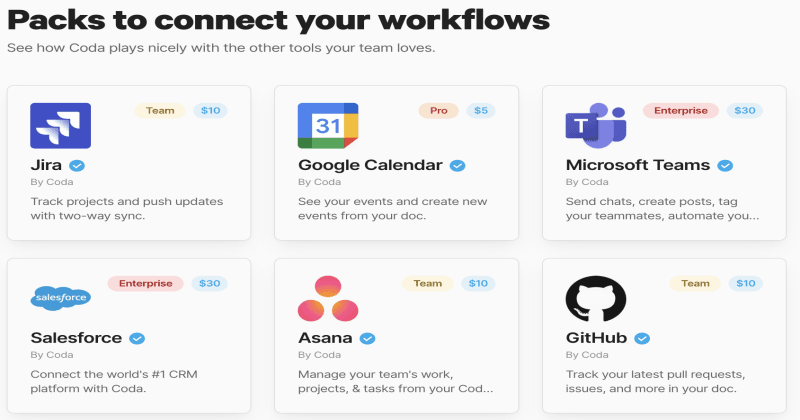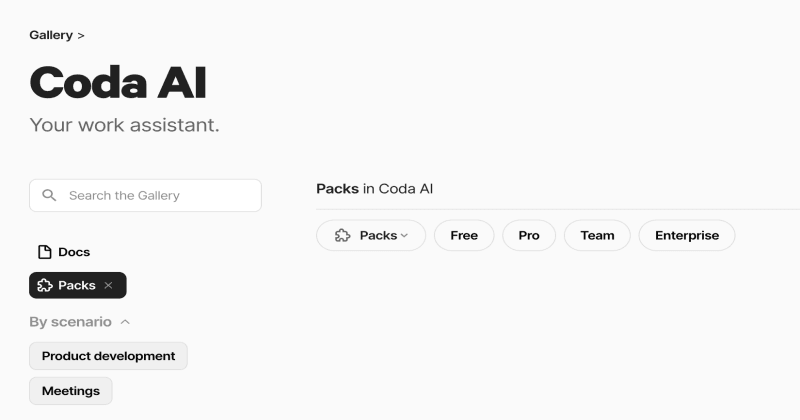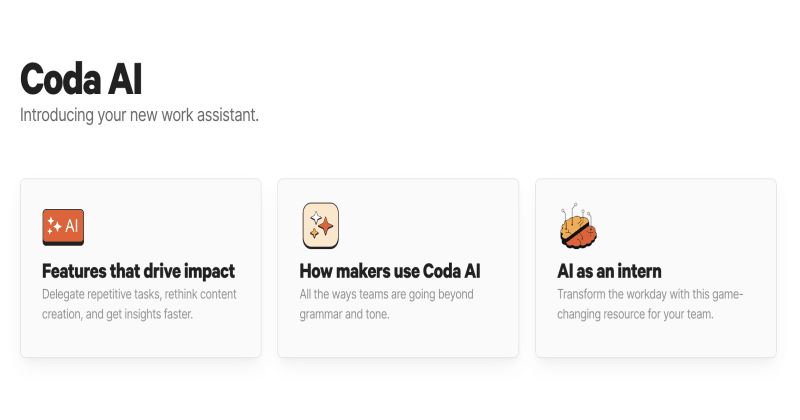Updated: April 25, 2024- 13 min read
Hey, Product people! Buckle up, because we're diving into the fascinating world of AI-empowered work with none other than Lane Shackleton, the mastermind CPO at Coda!
Editorial Note: What you're about to read is an interview-style post based on a fireside chat with Lane Shackleton, the CPO at Coda. For the sake of clarity and transparency, please note that some expressions or words may have been edited or rephrased. You can watch the interview in full above.
Carlos here, founder and CEO of Product School. Today, we're pulling back the curtain on a topic that's red-hot right now: how to supercharge your product teams with AI tools.
I've scored some one-on-one time with Lane Shackleton, CPO of Coda and practically an encyclopedia on AI. Lane is going to walk us through his own journey as Coda's CPO. And not just that, he's all set to give us some exclusive, actionable advice—complete with real-world examples that you can take back to your team.

So, grab your notepads, because you're about to get a fast-paced ping-pong of questions and insights that might just be your aha moment. Ready?
Q1: Your company's growth has been remarkable. Let's dive into your seven-year journey as CPO at Coda. How has the product team evolved since you first joined?
When I first stepped into Coda, it was a small, close-knit group. Going from a bustling nine years at Google and YouTube with jam-packed calendars and a constant flow of 500 emails per day, I suddenly found myself in a quieter setting. My days went from overwhelming to a clean slate—mostly spent brainstorming at a whiteboard with Shishir, Matt, Alex, and a few others.
In those initial years, we intentionally kept the product team compact, waiting for the product to find its footing and gain some market traction. As the product's direction became clearer, we knew it was time to scale up. Over the next five years, our team grew and evolved, and now we boast a robust 30-member product and design team, evenly split between Product Managers and designers.
Q2: You're in the unique position of being both the creator and user of Coda. How does wearing both hats influence your product mindset? Could you share some specific ways your team uses Coda to serve other users?
Being both the creator and a frequent user of your own product is a fascinating dynamic. You find yourself in two mental spaces—on one hand, you're an opinionated Product Manager frustrated by any friction you encounter, while on the other, you have to remember you're not necessarily the ultimate customer. Balancing these dual perspectives calls for a deep sense of empathy and an insatiable curiosity for what's happening outside your own organization. Otherwise, the product can easily become swayed by internal feedback loops, given that you're using it day in, and day out and have strong opinions about its functionality.
In terms of how we use Coda internally, it's woven into the very fabric of our operations. From planning and OKRs to decision-making write-ups and customer communications—Coda serves as the backbone for virtually every process and ritual we have. Our team is obsessed with understanding and adopting best practices in product development. We're in the privileged position of having a front-row seat to the inner workings of hundreds of product teams worldwide.
We aim to learn from the best and apply those insights to our own processes, while also sharing nuggets of wisdom through platforms like the Coda gallery, which is a treasure trove of innovative product development methods.

Q3: Transitioning from tools like Google Sheets or Docs to a new, all-in-one platform like Coda can be challenging. How do you design the onboarding process to help new users quickly find value, and how do templates or artifacts play into this?
The first impression we aim for when you engage with Coda is simplicity. We've intentionally designed the initial experience to be a blinking cursor, where you can jot down an idea, draft a brief, or create a document—essentially what you're already familiar with. Sticking to the familiar has been a key strategy throughout Coda's development.
However, we also understand you're not here to simply explore a new platform; you have work that needs doing. We often hear about teams scattered across multiple tools, leading to fragmented conversations asking for various links. In a landscape of isolated docs and sheets, organization can become chaotic.
This is where Coda stands out. It serves as a centralized source of truth, allowing you to place a brief right beside a task list or adjacent to a decision-making template. We start by giving you a familiar setup—akin to the simple documents you're used to. Then, we guide you through the process of adapting the platform to fit your team's evolving needs. The message is clear: Don't adapt to how other teams work; make the tool adapt to your team's unique processes and rituals. We've seen a plethora of ingenious ways our users have done just that, and that's what makes Coda so dynamic.
Q4: For a tool to truly become a 'platform' in this diversified tech scenario, integration is key. Not just for the tool itself but also to let third-party developers build on it. Could you tell us how Coda managed to become an integral part of the average tech stack and also expanded its utility by opening up to external apps?
You've hit the nail on the head. The dream of a one-stop-shop tool that effortlessly integrates into a tech professional's existing stack is ambitious, to say the least. Recognizing this, we introduced what we call "Packs," our foundational framework for integrations.
Traditional integrations between tools—say, Jira integrating with Asana—are often point-to-point and may cover 80% of your needs but leave the remaining 20% hanging. Our vision behind Packs was different: allow users to fully engage with these tools via our platform. So, if you've got Jira tasks, you can pull those into a Coda table and work on them alongside your briefs or write-ups. This holistic approach to integration allows for a unified workflow.
Then came the game-changer. About two years ago, we opened up the platform for anyone to build a Pack. This transformed the landscape from us building maybe 50 packs to a flourishing ecosystem of over 600 packs. Now, when users want to integrate a new tool into Coda, the chances are high that they'll find a ready-made Pack for it.
More recently, we've introduced "Page Embeds." This feature addresses specific needs—maybe your legal team insists on using Google Docs for compliance reasons, or someone needs a Google Slide for customer presentations. With Page Embeds, you can pull in these specialized tools as full-page embeds in Coda. Whether it's Figma prototypes, Miro boards, or Google Docs, everything can co-exist within Coda's environment.
The ultimate goal is for Coda to be the go-to hub for your team—a singular link that aggregates and meaningfully integrates all your essential tools. And from the feedback we're receiving, it seems we're getting closer to making that vision a reality.

Q5: Transitioning from being solely a creator to also being a curator involves a different set of challenges. Specifically, when it comes to collaborating with external product teams, how do you balance control with flexibility?
Flexibility is one of Coda's core strengths, allowing users to build nearly anything they want. However, this freedom also raises the question: What should we actually build? In this sense, our relationship with external product teams tends to be consultative. We focus on understanding what their core objectives are and how we can help meet them.
For instance, if a product leader tells me they're struggling with inefficient decision-making processes, we'll work together to design an ideal template to streamline that area. We might even suggest implementing a system, like review meetings, built around that template. In essence, we function as coaching partners—knowing when to offer guidance and when to step back and listen.
Our ongoing learning process is aided by the unique vantage point we have in various product teams' successes and challenges. Whether it's improving decision-making, overhauling planning processes, or enhancing meeting efficiency, our aim is to make those elements more effective. We constantly adapt and tweak our approach based on what's working and what isn't, all while helping external teams fine-tune their own practices.
Q6: As products continue to evolve, AI-empowered work is playing a growing role. Can you share your experience learning about AI and identifying ways it can enhance your product?
My learning philosophy is to make the experience as playful as possible. In that spirit, at Coda, we encourage our team to explore and play with new tools to understand their potential and limitations.
In terms of applying AI to our product, our ambition goes beyond being just a writing assistant. We aim to be a comprehensive work assistant that takes care of mundane tasks, like summarizing meetings and customer feedback. Our product development has focused on several AI-driven features, such as Magic Block and Magic Columns, which allow for dynamic context-based actions and data manipulation. These tools aim to make our product more versatile, evolving from merely aiding in writing to becoming a more all-encompassing work assistant.

Q7: AI technology is full of potential, but it can be overwhelming. How do you guide users through the onboarding process for AI features to help them gradually realize the tech’s capabilities?
The user interface (UI) of AI is often mistaken as the entire value of a product. While chat interfaces have become synonymous with AI, they may not be the best fit for every application. At Coda, we offer small, tangible AI features, like auto-filling a status column based on other data, as stepping stones to building user trust.
Another principle we adhere to is creating fault-tolerant interfaces. AI-empowered work is not infallible, especially when it comes to generative tasks. Therefore, we design our AI features to allow for easy user corrections. This flexibility ensures that while AI serves as a helpful starting point, the user always has the final say, thus gradually building trust and adoption as the technology continues to improve.
Q8: In the evolving field of AI, how do you differentiate between hype and genuine value when incorporating technology into your product?
Absolutely, it's crucial to be discerning when it comes to integrating AI-empowered work into a product. David Kosnik, an AI lead, aptly compares AI to a team of highly intelligent interns. While you wouldn't entrust them to do your entire job, they can be invaluable for specific tasks. For instance, AI can provide strategic insights when given intentional prompts, as I've seen with GPT-4. The idea is to find novel and practical ways to utilize AI that genuinely add value, instead of simply using it as a buzzword to attract investors or customers.
Q9: For product leaders looking to harness the potential of AI, what approach would you recommend for self-education and career acceleration?
My first piece of advice is to dive right in. Immersive learning experiences are far more effective than observing from the sidelines. Engage in conversations with experts, experiment with the technology, and work on actual projects. This hands-on approach will provide invaluable insights.
Secondly, remember that it's still early days in the AI journey. Reid Hoffman, one of our investors, constantly reminds us of this. Adopt a long-term mindset, gain a foundational understanding, and then start to form your own opinions. Listen to experts, read extensively, and play around with different tools, but eventually, you need to develop your own thesis on how this technology will evolve in your particular context.

Q10: Considering your advice, can you share your vision for AI's role in your product and the broader ecosystem three years from now?
I envision AI transforming how work is done on multiple fronts. Take product managers, for example, who often find themselves doing repetitive tasks they describe as "human copy-pasting." AI can eliminate these low-value tasks, allowing professionals to focus on higher-value work like customer empathy and market analysis, which are fundamentally human skills.
Furthermore, I think we'll see significant advancements in how we interact with AI. Current AI interfaces often require tedious, text-based interactions to gather context. I recently experimented with a tool called PI, a personalized AI assistant, and although it asked me intelligent questions, the text-based conversation felt laborious. In the future, I expect more dynamic and natural forms of interaction with AI, perhaps through audio or other interfaces.
Q11: What can we expect to be discussing when we revisit this conversation six months from now?
I'm sure that in six months, the landscape will have shifted in ways we can't entirely predict. Some trends we consider groundbreaking today might become obsolete, while unnoticed developments could take center stage. Either way, I appreciate this opportunity to share my insights and experiences in this evolving field. Thank you for having me, and I'm looking forward to our continued dialogue in the future.
Key Takeaways
I trust you've found these insights as enlightening as I have. It's always a treasure trove of knowledge when we dive into subjects as multi-layered as AI-empowered work. To make sure the essence of our discussion doesn't get lost in the shuffle, let's recap the key takeaways that can serve as your arsenal for supercharging your work:

1. Approach AI as a team of super-smart interns
Don't expect AI to handle everything; instead, delegate specific tasks where AI can genuinely add value.
2. Get into the arena of AI
To truly grasp the ins and outs of this technology, immerse yourself in it. Engage with experts, participate in projects, and get your hands dirty.
3. Having a long-arc mindset is key
Keep yourself updated but take the time to form your own well-informed opinions.
4. Consider value over hype
Don't just add AI to your product for the sake of being trendy. Make sure it solves a real problem or adds significant value.
5. Focus on high-value work
AI can handle the repetitive tasks, freeing you up to focus on customer-centric and strategy-based responsibilities, which often require a human touch.
6. Explore dynamic interfaces
Whether it's text-based or voice-controlled, how you interact with AI could change the game entirely. Be on the lookout for new paradigms.
7. Be open to change and adapt
What might not seem significant today could become groundbreaking tomorrow.
Until next time, keep learning, keep innovating, and most importantly, keep challenging the status quo. And a final huge shoutout to the one and only Lane Shackleton for letting me pick his brain and indulging my deep dives!
Updated: April 25, 2024





